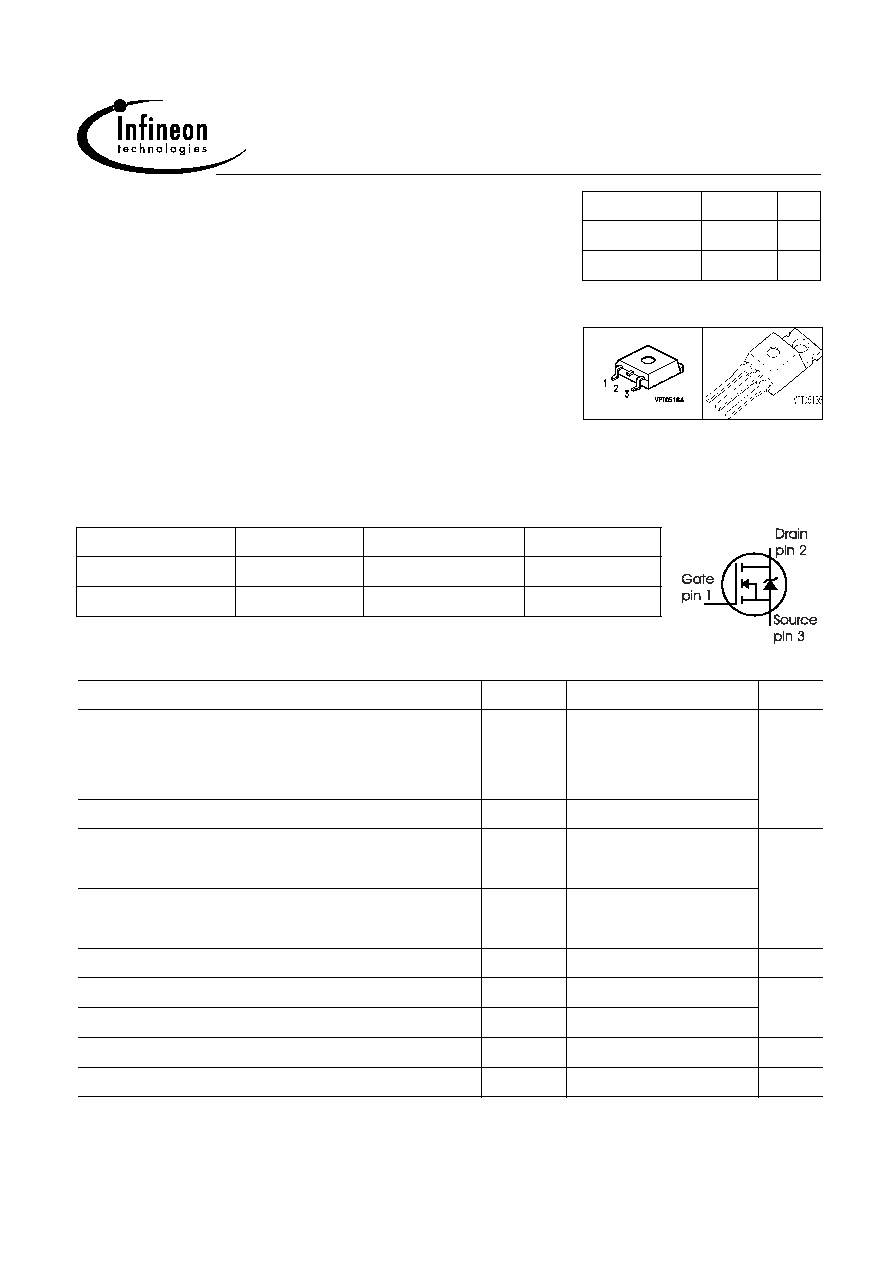
2003-10-02
Page 1
SPP02N60C3
SPB02N60C3
Final data
Cool MOSTM
Power Transistor
V
DS
@
T
jmax
650
V
R
DS(on)
3
I
D
1.8
A
Feature
∑
New revolutionary high voltage technology
∑
Ultra low gate charge
∑
Periodic avalanche rated
∑
Extreme dv/dt rated
∑
Ultra low effective capacitances
P-TO220-3-1
P-TO263-3-2
Type
Package
Ordering Code
SPP02N60C3
P-TO220-3-1
Q67040-S4392
SPB02N60C3
P-TO263-3-2
Q67040-S4393
Marking
02N60C3
02N60C3
Maximum Ratings
Parameter
Symbol
Value
Unit
Continuous drain current
T
C
= 25 ∞C
T
C
= 100 ∞C
I
D
1.8
1.1
A
Pulsed drain current,
t
p
limited by
T
jmax
I
D puls
5.4
Avalanche energy, single pulse
I
D
= 1.35 A,
V
DD
= 50 V
E
AS
50
mJ
Avalanche energy, repetitive t
AR
limited by
T
jmax
1)
I
D
= 1.8 A,
V
DD
= 50 V
E
AR
0.07
Avalanche current, repetitive t
AR
limited by
T
jmax
I
AR
1.8
A
Gate source voltage static
V
GS
±20
V
Gate source voltage AC (f >1Hz)
V
GS
±
30
Power dissipation,
TC = 25∞C
P
tot
25
W
Operating and storage temperature
T
j ,
T
stg
-55... +150
∞C

2003-10-02
Page 2
SPP02N60C3
SPB02N60C3
Final data
Maximum Ratings
Parameter
Symbol
Value
Unit
Drain Source voltage slope
V
DS
= 480 V, I
D
= 1.8 A,
T
j
= 125 ∞C
dv/dt
50
V/ns
Thermal Characteristics
Parameter
Symbol
Values
Unit
min.
typ.
max.
Thermal resistance, junction - case
R
thJC
-
-
5
K/W
Thermal resistance, junction - ambient, leaded
R
thJA
-
-
62
SMD version, device on PCB:
@ min. footprint
@ 6 cm
2
cooling area
2)
R
thJA
-
-
-
35
62
-
Soldering temperature,
1.6 mm (0.063 in.) from case for 10s
3)
T
sold
-
-
260
∞C
Electrical Characteristics, at Tj=25∞C unless otherwise specified
Parameter
Symbol
Conditions
Values
Unit
min.
typ.
max.
Drain-source breakdown voltage
V
(BR)DSS V
GS
=0V, I
D
=0.25mA
600
-
-
V
Drain-Source avalanche
breakdown voltage
V
(BR)DS
V
GS
=0V, I
D
=0.25A
-
700
-
Gate threshold voltage
V
GS(th)
I
D
=80
µ
,
V
GS
=
V
DS
2.1
3
3.9
Zero gate voltage drain current
I
DSS
V
DS
=600V,
V
GS
=0V,
T
j
=25∞C,
T
j
=150∞C
-
-
0.5
-
1
50
µA
Gate-source leakage current
I
GSS
V
GS
=30V,
V
DS
=0V
-
-
100
nA
Drain-source on-state resistance R
DS(on)
V
GS
=10V, I
D
=1.1A,
T
j
=25∞C
T
j
=150∞C
-
-
2.7
7.3
3
-
Gate input resistance
R
G
f=1MHz, open Drain
-
9
-

2003-10-02
Page 3
SPP02N60C3
SPB02N60C3
Final data
Electrical Characteristics , at
T
j
= 25 ∞C, unless otherwise specified
Parameter
Symbol
Conditions
Values
Unit
min.
typ.
max.
Transconductance
g
fs
V
DS
2*I
D
*R
DS(on)max
,
I
D
=1.1A
-
1.75
-
S
Input capacitance
C
iss
V
GS
=0V,
V
DS
=25V,
f
=1MHz
-
200
-
pF
Output capacitance
C
oss
-
90
-
Reverse transfer capacitance
C
rss
-
4
-
Effective output capacitance,
4)
energy related
C
o(er)
V
GS
=0V,
V
DS
=0V to 480V
-
8.1
-
pF
Effective output capacitance,
5)
time related
C
o(tr)
-
15.7
-
Turn-on delay time
t
d(on)
V
DD
=350V,
V
GS
=0/10V,
I
D
=1.8A,
R
G
=50
-
6
-
ns
Rise time
t
r
-
3
-
Turn-off delay time
t
d(off)
-
68
70
Fall time
t
f
-
12
30
Gate Charge Characteristics
Gate to source charge
Q
gs
V
DD
=420V, I
D
=1.8A
-
1.6
-
nC
Gate to drain charge
Q
gd
-
3.8
-
Gate charge total
Q
g
V
DD
=420V, I
D
=1.8A,
V
GS
=0 to 10V
-
9.5
12.5
Gate plateau voltage
V
(plateau)
V
DD
=420V, I
D
=1.8A
-
5.5
-
V
1Repetitve avalanche causes additional power losses that can be calculated as P
AV
=
E
AR
*
f
.
2Device on 40mm*40mm*1.5mm epoxy PCB FR4 with 6cm≤ (one layer, 70 µm thick) copper area for drain
connection. PCB is vertical without blown air.
3Soldering temperature for TO-263: 220∞C, reflow
4C
o(er)
is a fixed capacitance that gives the same stored energy as
C
oss
while
V
DS
is rising from 0 to 80% V
DSS
.
5C
o(tr)
is a fixed capacitance that gives the same charging time as
C
oss
while
V
DS
is rising from 0 to 80% V
DSS
.
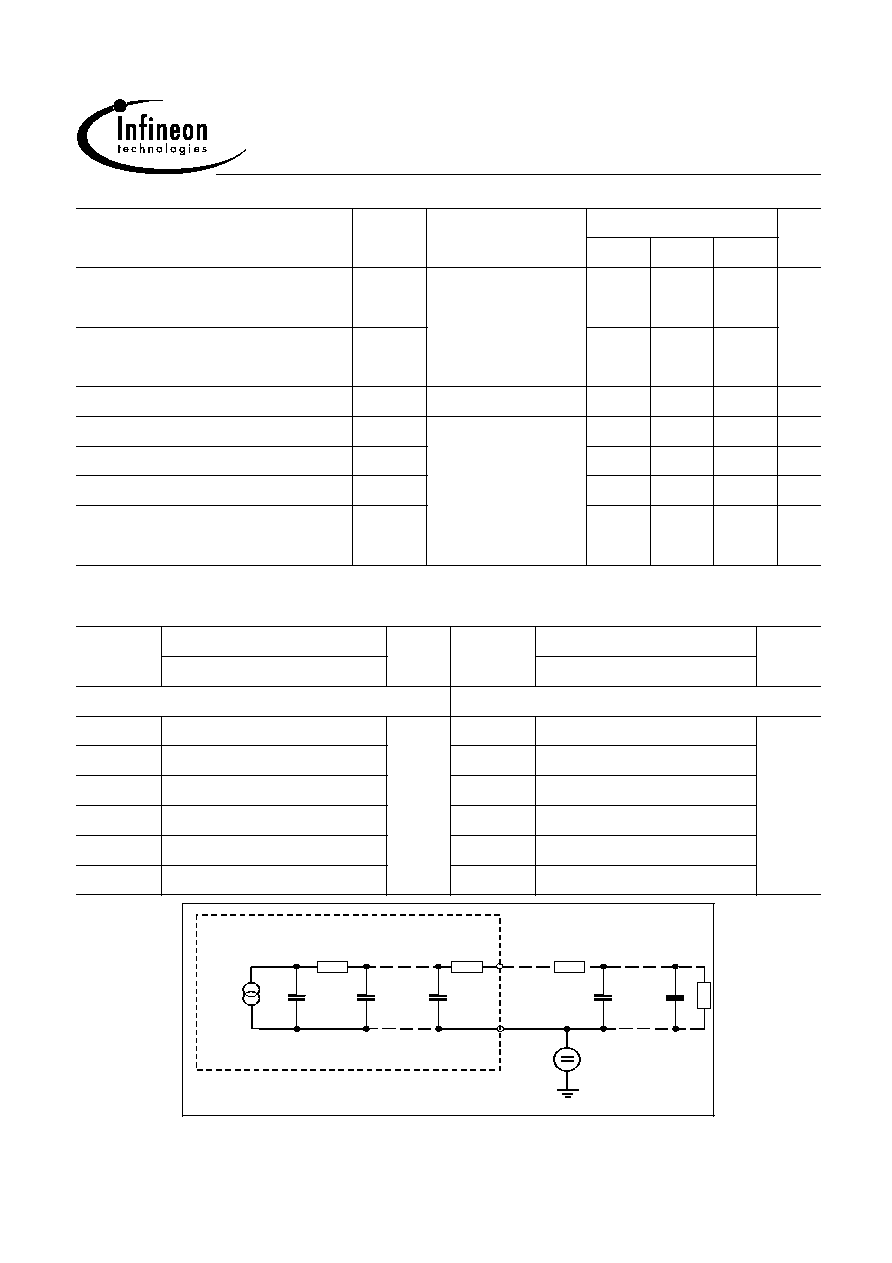
2003-10-02
Page 4
SPP02N60C3
SPB02N60C3
Final data
Electrical Characteristics, at
T
j
= 25 ∞C, unless otherwise specified
Parameter
Symbol
Conditions
Values
Unit
min.
typ.
max.
Inverse diode continuous
forward current
I
S
T
C
=25∞C
-
-
1.8
A
Inverse diode direct current,
pulsed
I
SM
-
-
5.4
Inverse diode forward voltage
V
SD
V
GS
=0V, I
F
=I
S
-
1
1.2
V
Reverse recovery time
t
rr
V
R
=420V, I
F
=I
S
,
di
F
/dt
=100A/µs
-
200
350
ns
Reverse recovery charge
Q
rr
-
1.3
-
µC
Peak reverse recovery current
I
rrm
-
9
-
A
Peak rate of fall of reverse
recovery current
di
rr
/dt
-
-
200
A/µs
Typical Transient Thermal Characteristics
Symbol
Value
Unit
Symbol
Value
Unit
typ.
typ.
Thermal resistance
R
th1
0.1
K/W
R
th2
0.184
R
th3
0.306
R
th4
1.207
R
th5
0.974
R
th6
0.251
Thermal capacitance
C
th1
0.00002806
Ws/K
C
th2
0.0001113
C
th3
0.0001679
C
th4
0.000547
C
th5
0.001388
C
th6
0.035
External H eatsink
T
j
T
case
T
am b
C
th1
C
th2
R
th1
R
th,n
C
th,n
P
tot
(t)
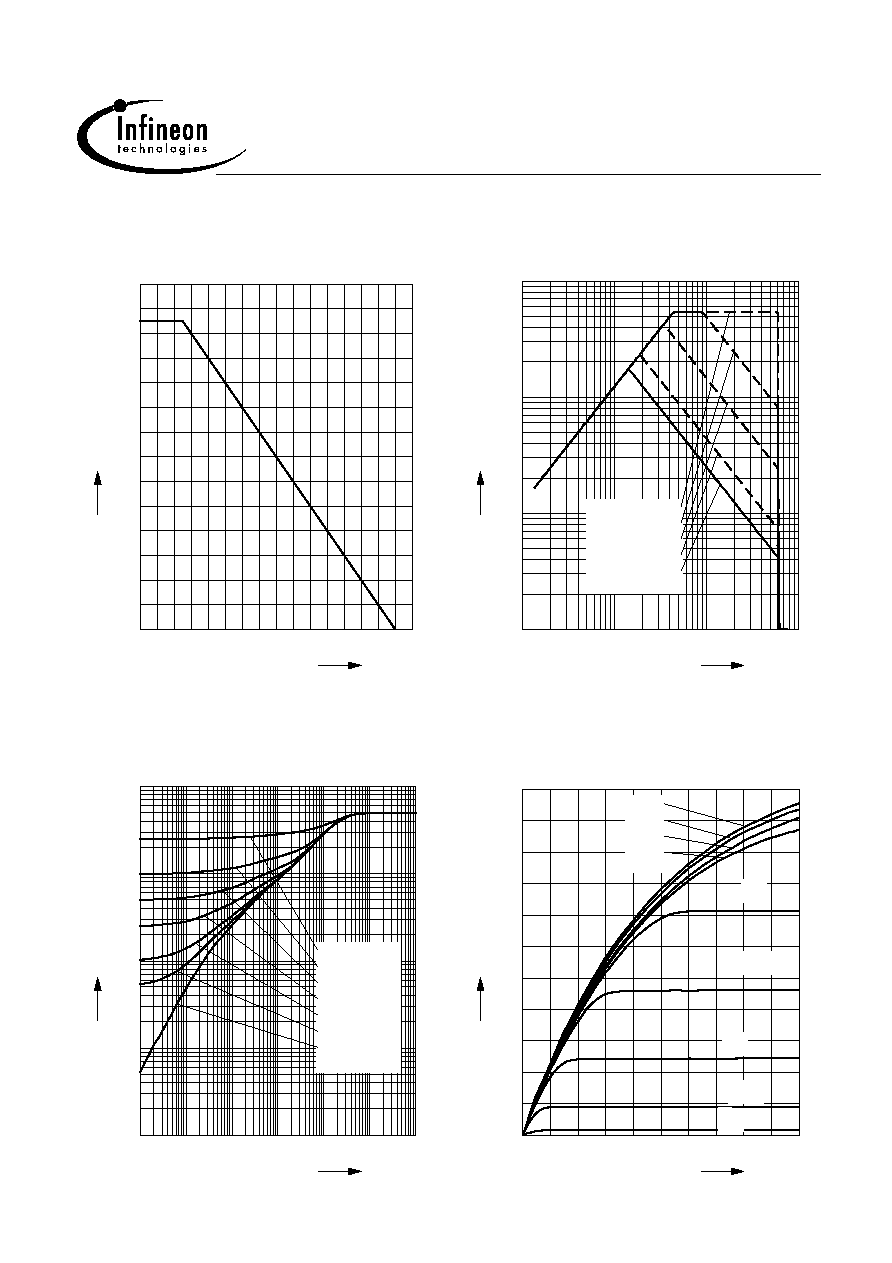
2003-10-02
Page 5
SPP02N60C3
SPB02N60C3
Final data
1 Power dissipation
P
tot
= f (
T
C
)
0
20
40
60
80
100
120
∞C
160
T
C
0
2
4
6
8
10
12
14
16
18
20
22
24
W
28
SPP02N60C3
P
tot
2 Safe operating area
I
D
= f ( V
DS
)
parameter : D = 0 ,
T
C
=25∞C
10
0
10
1
10
2
10
3
V
V
DS
-2
10
-1
10
0
10
1
10
A
I
D
tp = 0.001 ms
tp = 0.01 ms
tp = 0.1 ms
tp = 1 ,ms
DC
3 Transient thermal impedance
Z
thJC
= f (t
p
)
parameter: D = t
p
/T
10
-7
10
-6
10
-5
10
-4
10
-3
10
-1
s
t
p
-3
10
-2
10
-1
10
0
10
1
10
K/W
Z
thJC
D = 0.5
D = 0.2
D = 0.1
D = 0.05
D = 0.02
D = 0.01
single pulse
4 Typ. output characteristic
I
D
= f (
V
DS
);
T
j
=25∞C
parameter: t
p
= 10 µs,
V
GS
0
2
4
6
8
10
12
14
16
V
20
V
DS
0
0.5
1
1.5
2
2.5
3
3.5
4
4.5
A
5.5
I
D
V4.5
V4
V5
V5.5
V6
V20
V10
V7
V6.5
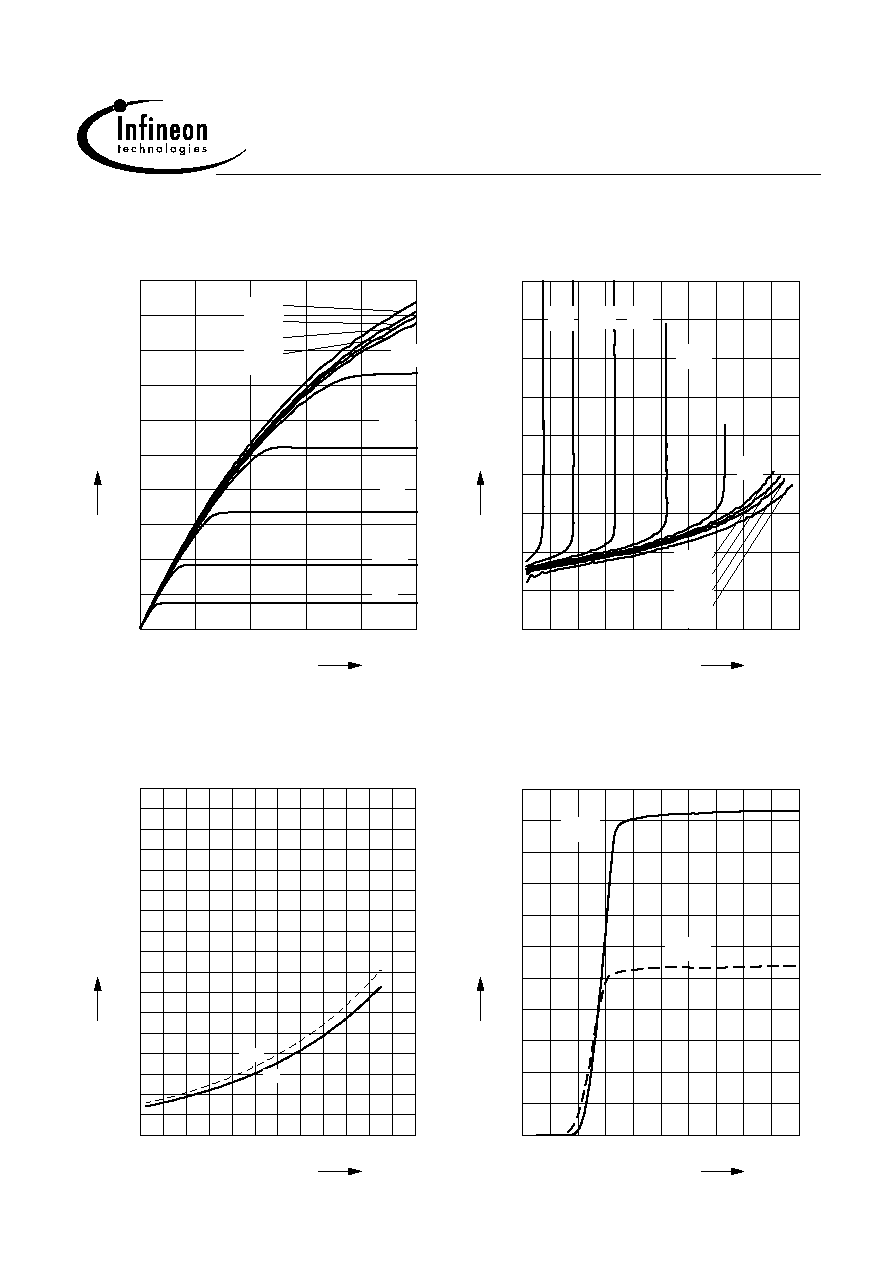
2003-10-02
Page 6
SPP02N60C3
SPB02N60C3
Final data
5 Typ. output characteristic
I
D
= f (
V
DS
);
T
j
=150∞C
parameter: t
p
= 10 µs,
V
GS
0
5
10
15
V
25
V
DS
0
0.3
0.6
0.9
1.2
1.5
1.8
2.1
2.4
A
3
I
D
4V
4.5V
5V
5.5V
6V
20V
8V
7V
6.5V
6 Typ. drain-source on resistance
R
DS(on)
=
f
(I
D
)
parameter:
T
j
=150∞C,
V
GS
0
0.3 0.6 0.9 1.2 1.5 1.8 2.1 2.4
A
3
I
D
2
4
6
8
10
12
14
16
20
R
DS
(
on)
4V
4.5V
5V
5,5V
6V
6.5V
7V
8V
20V
7 Drain-source on-state resistance
R
DS(on)
= f (T
j
)
parameter : I
D
= 1.1 A,
V
GS
= 10 V
-60
-20
20
60
100
∞C
180
T
j
0
2
4
6
8
10
12
14
17
SPP02N60C3
R
DS(on)
typ
98%
8 Typ. transfer characteristics
I
D
= f ( V
GS
); V
DS
2 x I
D
x R
DS(on)max
parameter: t
p
= 10 µs
0
2
4
6
8
10
12
14
16
V
20
V
GS
0
0.5
1
1.5
2
2.5
3
3.5
4
4.5
A
5.5
I
D
25∞C
150∞C
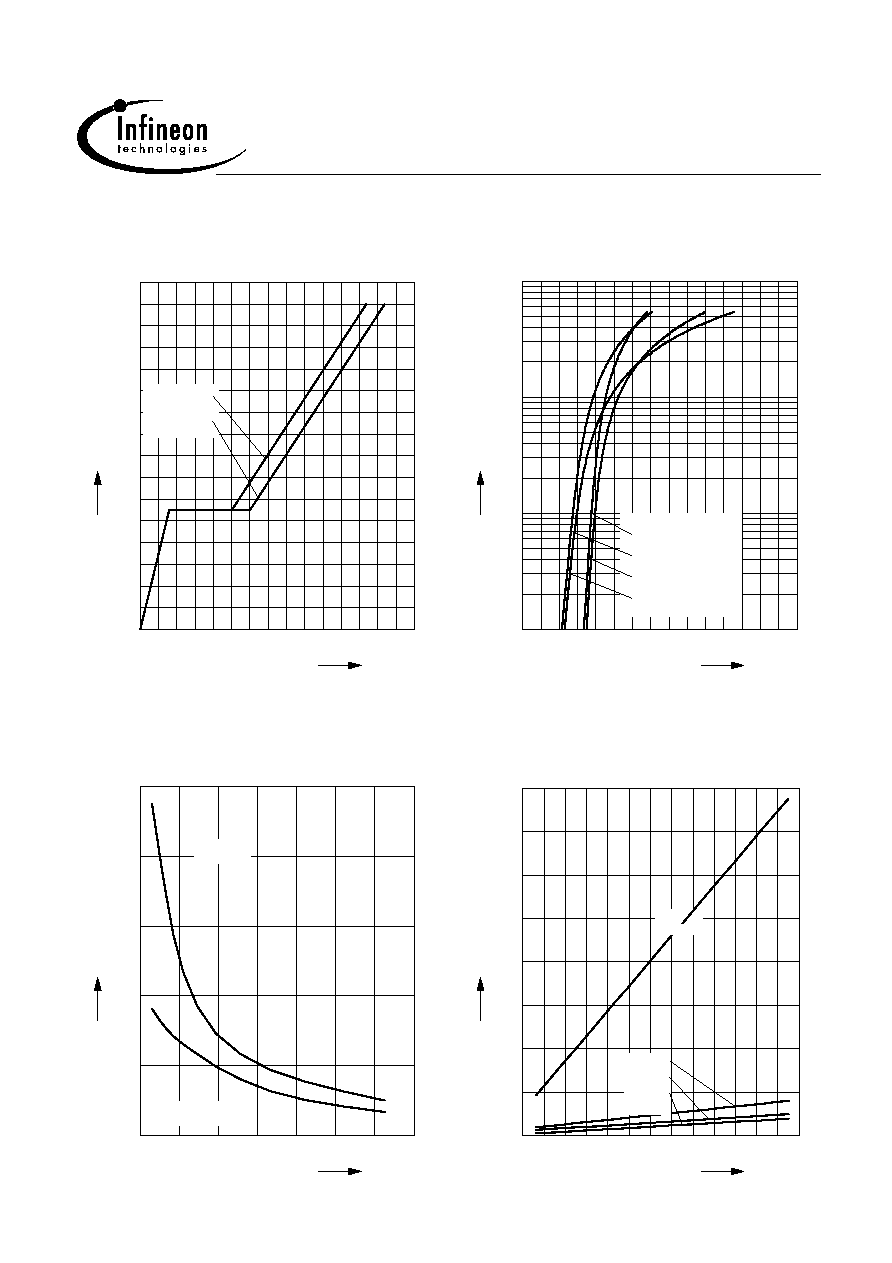
2003-10-02
Page 7
SPP02N60C3
SPB02N60C3
Final data
9 Typ. gate charge
V
GS
= f (Q
Gate
)
parameter: I
D
= 1.8 A pulsed
0
2
4
6
8
10
12 nC
15
Q
Gate
0
2
4
6
8
10
12
V
16
SPP02N60C3
V
GS
0.2
V
DS max
0.8
V
DS max
10 Forward characteristics of body diode
I
F
= f (V
SD
)
parameter: Tj , t
p
= 10 µs
0
0.4
0.8
1.2
1.6
2
2.4
V
3
V
SD
-2
10
-1
10
0
10
1
10
A
SPP02N60C3
I
F
T
j
= 25 ∞C typ
T
j
= 25 ∞C (98%)
T
j
= 150 ∞C typ
T
j
= 150 ∞C (98%)
11 Typ. drain current slope
di/dt
= f(
R
G
), inductive load,
T
j
= 125∞C
par.:
V
DS
=380V,
V
GS
=0/+13V, I
D
=1.8A
0
40
80
120
160
200
280
R
G
0
200
400
600
A/µs
1000
d
i
/d
t
di/dt(on)
di/dt(off)
12 Typ. switching time
t = f (
R
G
), inductive load,
T
j
=125∞C
par.:
V
DS
=380V,
V
GS
=0/+13V, I
D
=1.8 A
0
40
80
120
160
200
260
R
G
0
50
100
150
200
250
300
ns
400
t
td(off)
tf
td(on)
tr
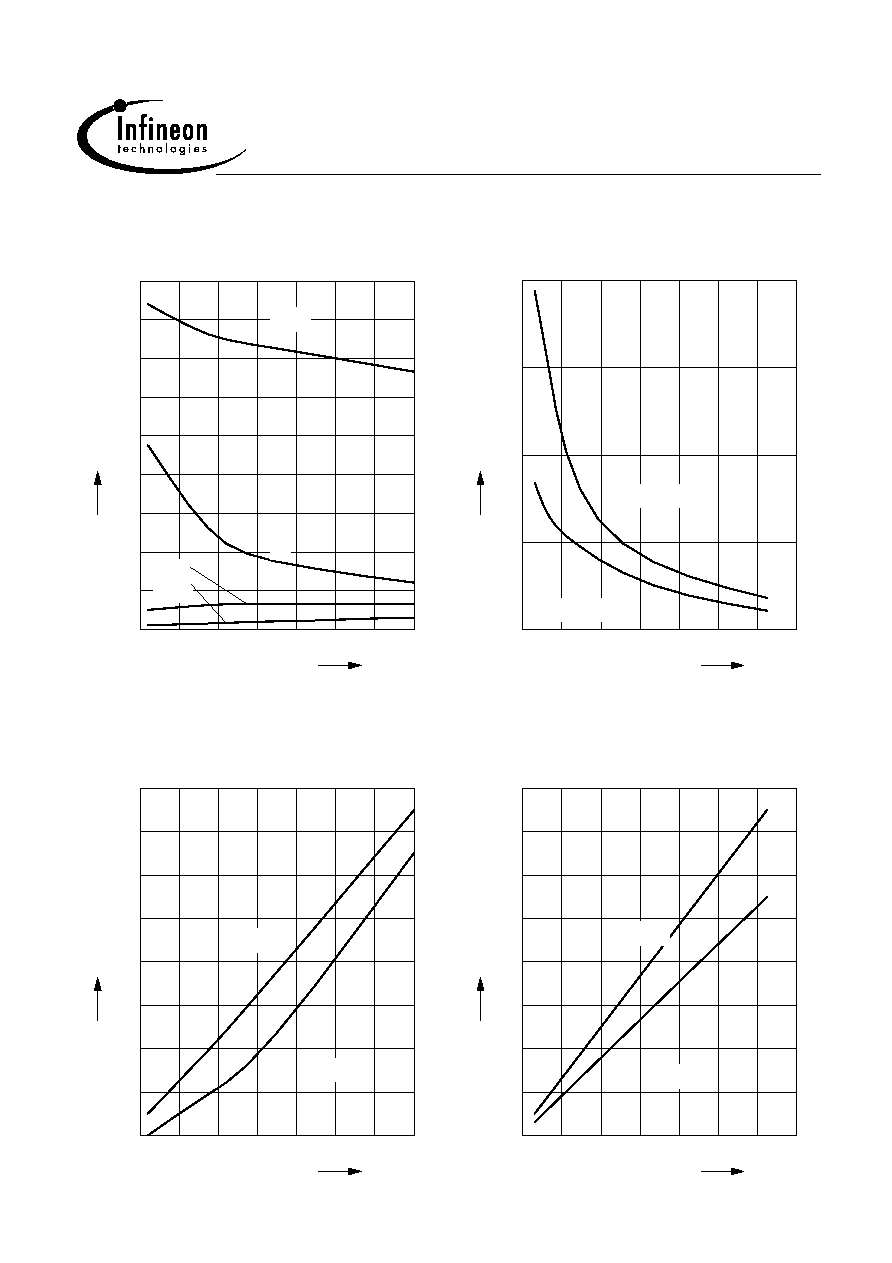
2003-10-02
Page 8
SPP02N60C3
SPB02N60C3
Final data
13 Typ. switching time
t = f (I
D
), inductive load,
T
j
=125∞C
par.:
V
DS
=380V,
V
GS
=0/+13V,
R
G
=50
0.25
0.5
0.75
1
1.25
1.5
A
2
I
D
0
10
20
30
40
50
60
70
ns
90
t
tdoff
tf
tdon
tr
14 Typ. drain source voltage slope
dv/dt
= f(
R
G
), inductive load,
T
j
= 125∞C
par.:
V
DS
=380V,
V
GS
=0/+13V, I
D
=1.8A
0
40
80
120
160
200
280
R
G
5000
25000
45000
V/ns
85000
d
v
/d
t
dv/dt(on)
dv/dt(off)
15 Typ. switching losses
E = f (I
D
), inductive load,
T
j
=125∞C
par.:
V
DS
=380V,
V
GS
=0/+13V,
R
G
=50
0.25
0.5
0.75
1
1.25
1.5
A
2
I
D
0.002
0.003
0.004
0.005
0.006
0.007
0.008
mWs
0.01
E
Eoff
Eon
16 Typ. switching losses
E = f(
R
G
), inductive load,
T
j
=125∞C
par.:
V
DS
=380V,
V
GS
=0/+13V, I
D
=1.8A
0
40
80
120
160
200
280
R
G
0.0025
0.0075
0.0125
0.0175
0.0225
0.0275
0.0325
mWs
0.0425
E
Eoff
Eon
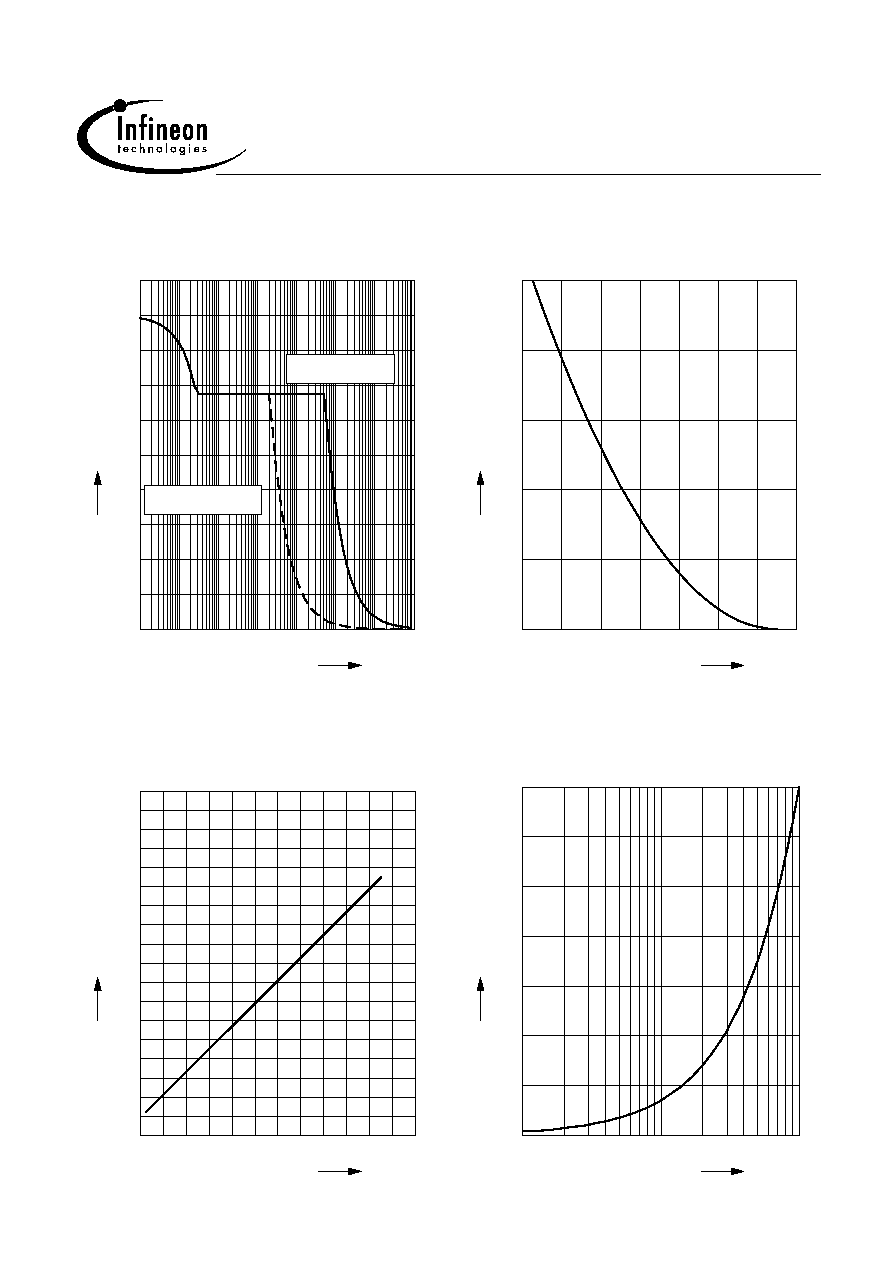
2003-10-02
Page 9
SPP02N60C3
SPB02N60C3
Final data
17 Avalanche SOA
I
AR
= f (t
AR
)
par.:
T
j
150 ∞C
10
-3
10
-2
10
-1
10
0
10
1
10
2
10
4
µs
t
AR
0
0.2
0.4
0.6
0.8
1
1.2
1.4
1.6
A
2
I
AR
T
j(START)
=25∞C
T
j(START)
=125∞C
18 Avalanche energy
E
AS
= f (
T
j
)
par.: I
D
= 1.35 A,
V
DD
= 50 V
20
40
60
80
100
120
∞C
160
T
j
0
10
20
30
mJ
50
E
AS
19 Drain-source breakdown voltage
V
(BR)DSS
= f (
T
j
)
-60
-20
20
60
100
∞C
180
T
j
540
560
580
600
620
640
660
680
V
720
SPP02N60C3
V
(BR)DSS
20 Avalanche power losses
P
AR
= f (
f
)
parameter:
E
AR
=0.07mJ
10
4
10
5
10
6
Hz
f
0
10
20
30
40
50
W
70
P
AR
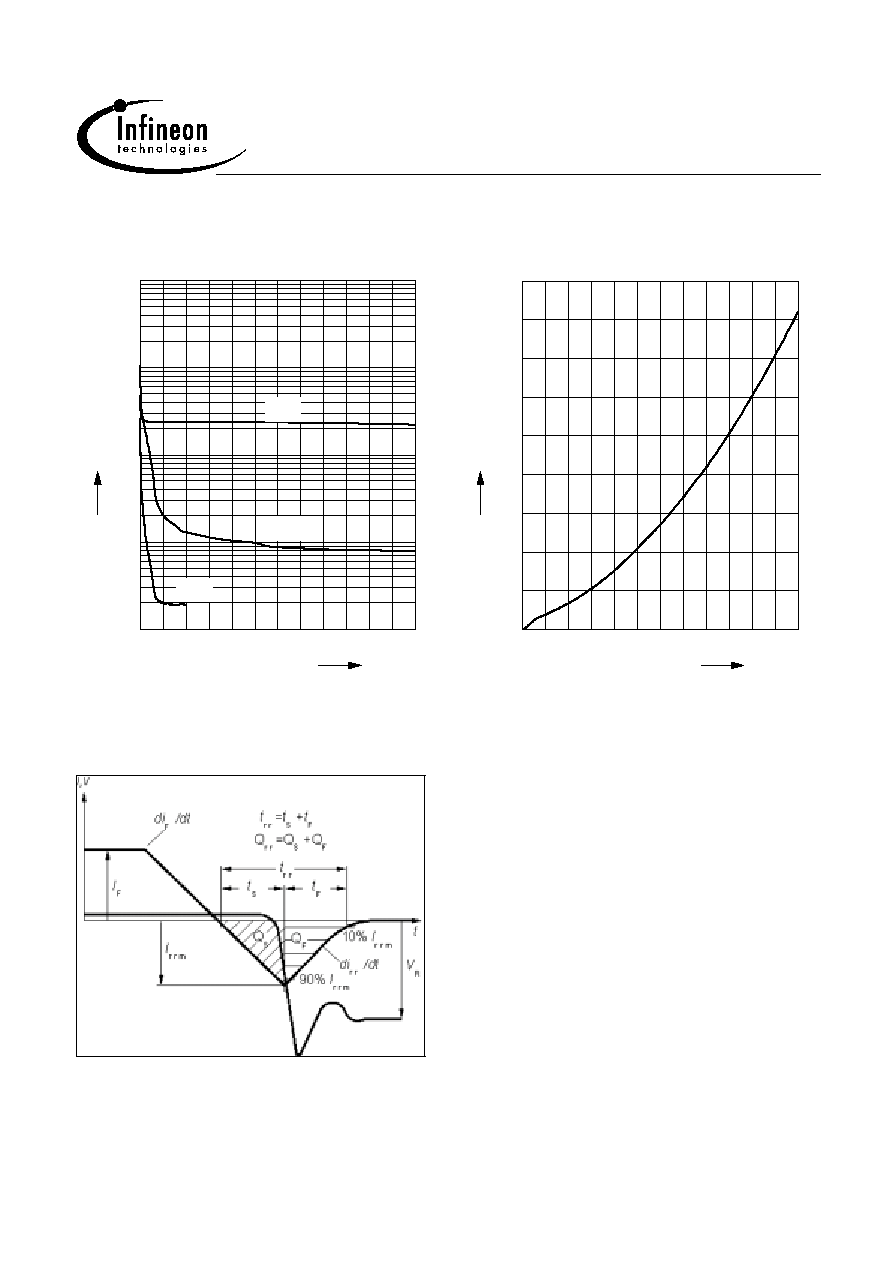
2003-10-02
Page 10
SPP02N60C3
SPB02N60C3
Final data
21 Typ. capacitances
C = f (
V
DS
)
parameter:
V
GS
=0V, f=1 MHz
0
100
200
300
400
V
600
V
DS
0
10
1
10
2
10
3
10
4
10
pF
C
Ciss
Coss
Crss
22 Typ.
C
oss
stored energy
E
oss
=
f
(
V
DS
)
0
100
200
300
400
V
600
V
DS
0
0.2
0.4
0.6
0.8
1
1.2
1.4
µJ
1.8
E
oss
Definition of diodes switching characteristics
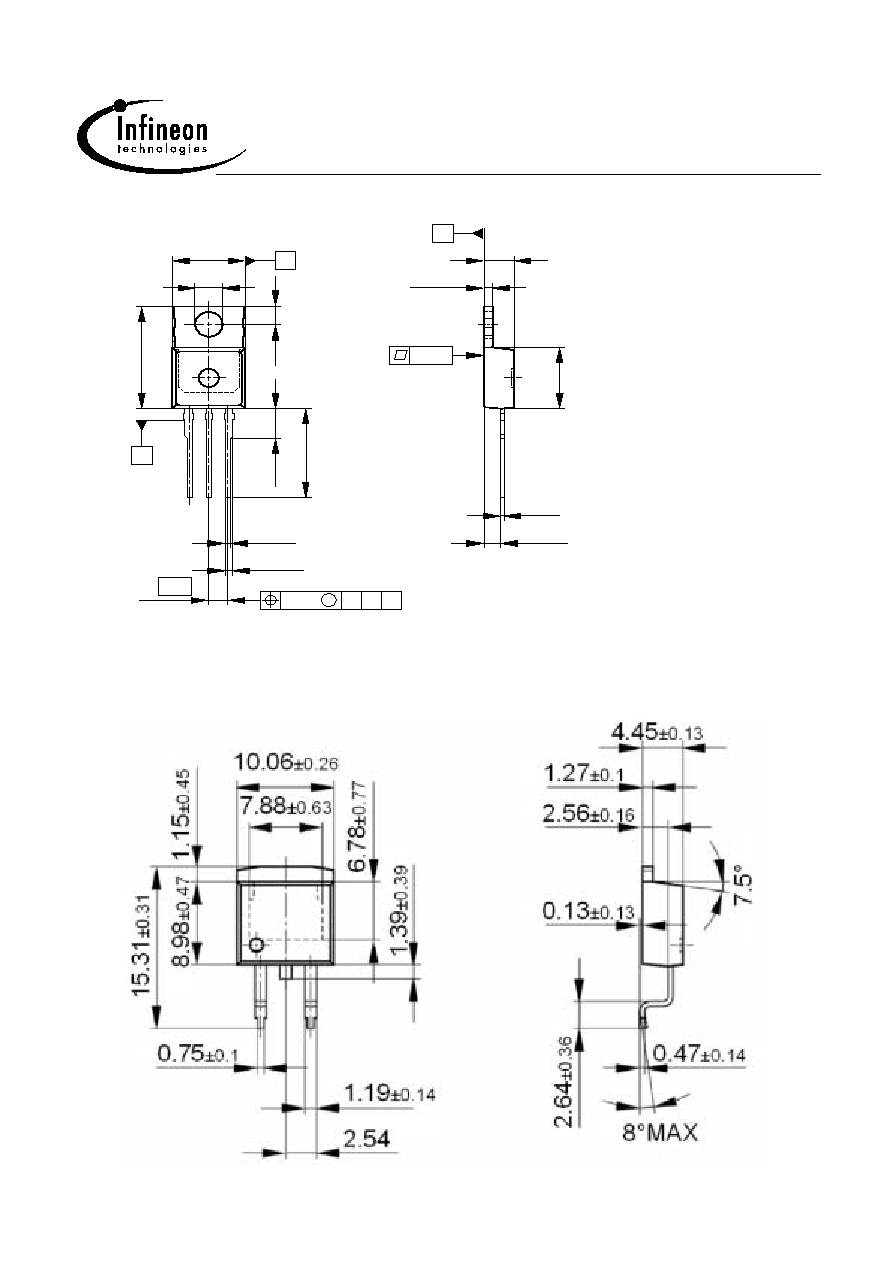
2003-10-02
Page 11
SPP02N60C3
SPB02N60C3
Final data
P-TO-220-3-1
A
B
A
0.25
M
2.8
15.38
±0.6
2.54
0.75
±0.1
±0.13
1.27
4.44
B
9.98
±0.48
0.05
All metal surfaces tin plated, except area of cut.
C
±0.2
10
±0.4
3.7
C
0.5
±0.1
±0.9
5.23
13.5
±0.5
3x
Metal surface min. x=7.25, y=12.3
2x
±0.2
±0.22
1.17
±0.2
2.51
P-TO-263-3-2 (D
2
-PAK)

2003-10-02
Page 12
SPP02N60C3
SPB02N60C3
Final data
Published by
Infineon Technologies AG,
Bereichs Kommunikation
St.-Martin-Strasse 53,
D-81541 M¸nchen
© Infineon Technologies AG 1999
All Rights Reserved.
Attention please!
The information herein is given to describe certain components and shall not be considered as warranted
characteristics.
Terms of delivery and rights to technical change reserved.
We hereby disclaim any and all warranties, including but not limited to warranties of non-infringement,
regarding circuits, descriptions and charts stated herein.
Infineon Technologies is an approved CECC manufacturer.
Information
For further information on technology, delivery terms and conditions and prices please contact your nearest
Infineon Technologies Office in Germany or our Infineon Technologies Reprensatives worldwide (see address list).
Warnings
Due to technical requirements components may contain dangerous substances.
For information on the types in question please contact your nearest Infineon Technologies Office.
Infineon Technologies Components may only be used in life-support devices or systems with the express
written approval of Infineon Technologies, if a failure of such components can reasonably be expected to
cause the failure of that life-support device or system, or to affect the safety or effectiveness of that device
or system Life support devices or systems are intended to be implanted in the human body, or to support
and/or maintain and sustain and/or protect human life. If they fail, it is reasonable to assume that the health
of the user or other persons may be endangered.











